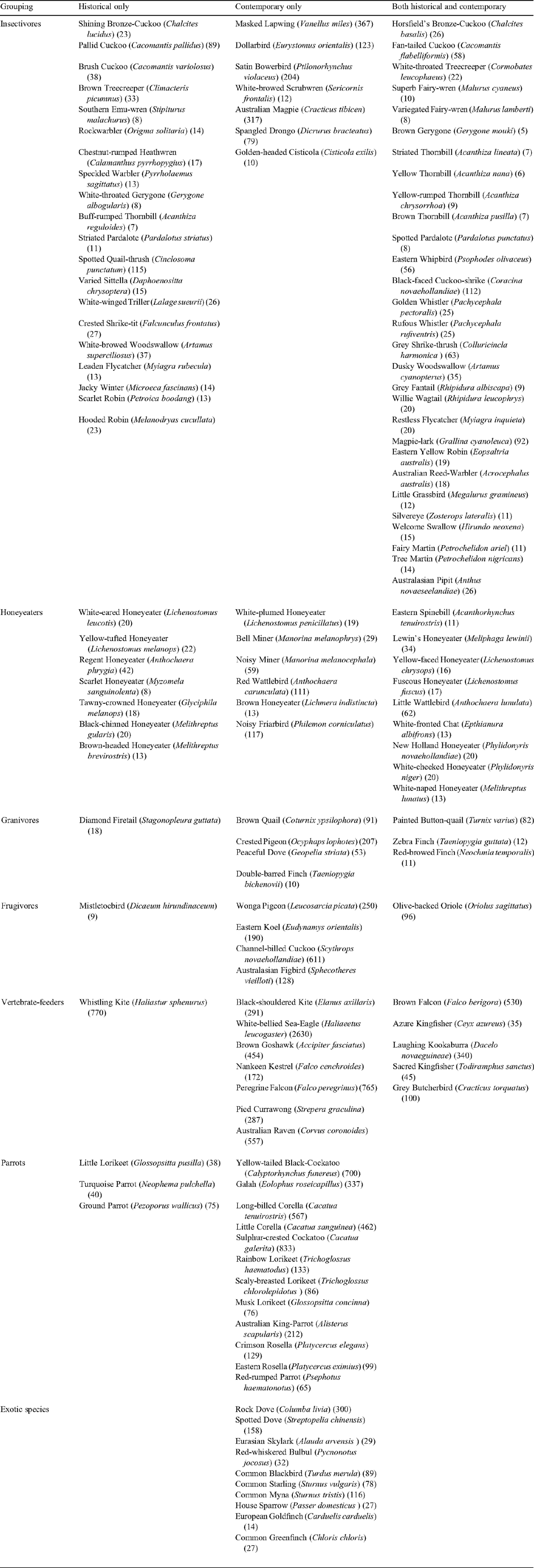What do museum specimens tell us about the impact of urbanisation? A comparison of the recent and historical bird communities of Sydney
Richard E. Major A C and Holly Parsons A BA Terrestrial Ecology, Australian Museum, 6 College St, Sydney, NSW 2010, Australia.
B Present address: Birds in Backyards Program, Birds Australia, Bird Discovery Centre, 1 Jamieson St, Sydney Olympic Park, NSW 2127, Australia.
C Corresponding author. Email: richard.major@austmus.gov.au
Emu 110(1) 92-103 https://doi.org/10.1071/MU09058
Submitted: 26 June 2009 Accepted: 7 December 2009 Published: 24 February 2010
Abstract
Most research investigating the effect of urbanisation on animals infers temporal change by comparing the species composition of present urban habitats with that of nearby ‘natural’ sites. In regions with a long history of human habitation and large human populations, there are sometimes sizeable museum collections that provide direct evidence of the distribution of animals present before urbanisation. This study identifies changes in the bird community of Sydney associated with urbanisation, by comparing the pre-1900 bird community determined from the ornithological databases of the Australian Museum and Museum Victoria, with the bird community of 1998–99 determined from Birds Australia’s Atlas database. The major difference in the bird community between the two periods was a shift in body size, with large species comprising a greater proportion of the recent bird community than small birds. The source of this difference was a result of both a relative decline in the small species within bird groupings (e.g. small insectivores) and to a relative increase in groupings dominated by larger species (e.g. parrots and vertebrate feeders). These results are similar to those obtained from comparison of urban areas and nearby natural sites.
Additional keywords: body size, insectivore, Noisy Miner, parrot, suburban, urban.
Acknowledgements
We are grateful to Birds Australia, Museum Victoria, Melbourne, and the Australian Museum, Sydney, for making their data available to us. We thank Greg Gowing, Walter Boles and Wayne Longmore for extracting data from museum collections and Andrew Silcocks for extracting data from the Birds Australia Atlas database. Thanks also to Michael Byrne, Kris French, John Martin, Jaynia Sladek and John White for their helpful suggestions on the draft manuscript.
Anderies, J. M. , Katti, M. , and Shochat, E. (2007). Living in the city: resource availability, predation, and bird population dynamics in urban areas. Journal of Theoretical Biology 247, 36–49.
| Crossref | GoogleScholarGoogle Scholar | PubMed |
Bass, D. A. (1995). The contribution of introduced fruits to the winter diet of Pied Currawongs in Armidale, NSW. Corella 19, 127–132.
Blair, R. B. (1996). Land use and avian species diversity along an urban gradient. Ecological Applications 6, 506–519.
| Crossref | GoogleScholarGoogle Scholar |
Blair, R. B. , and Johnson, E. M. (2008). Suburban habitats and their role for birds in the urban–rural habitat network: points of local invasion and extinction? Landscape Ecology 23, 1157–1169.
| Crossref | GoogleScholarGoogle Scholar |
Case, T. J. (1996). Global patterns in the establishment and distribution of exotic birds. Biological Conservation 78, 69–96.
| Crossref | GoogleScholarGoogle Scholar |
Clergeau, P. , Savard, J. P. L. , Mennechez, G. , and Falardeau, G. (1998). Bird abundance and diversity along an urban-rural gradient: a comparative study between two cities on different continents. Condor 100, 413–425.
| Crossref | GoogleScholarGoogle Scholar |
Crooks, K. R. , Suarez, A. V. , Bolger, D. T. , and Soule, M. E. (2001). Extinction and colonization of birds on habitat islands. Conservation Biology 15, 159–172.
Holway, D. A. , and Suarez, A. V. (1999). Animal behaviour: an essential component of invasion biology. Trends in Ecology & Evolution 14, 328–330.
| Crossref | GoogleScholarGoogle Scholar |
Martin, J. M. , French, K. , and Major, R. E. (2007). The pest status of Australian white ibis (Threskiornis molucca) in urban situations and the effectiveness of egg-oil in reproductive control. Wildlife Research 34, 319–324.
| Crossref | GoogleScholarGoogle Scholar |
Mason, P. (1985). The impact of urban development on bird communities of three Victorian towns – Lilydale, Coldstream and Mt Evelyn. Corella 9, 14–21.
White, J. G. , Antos, M. J. , Fitzsimons, J. A. , and Palmer, G. C. (2005). Non-uniform bird assemblages in urban environments: the influence of streetscape vegetation. Landscape and Urban Planning 71, 123–135.
| Crossref | GoogleScholarGoogle Scholar |

Wood, K. A. (1996). Bird assemblages in a small public reserve and adjacent residential area at Wollongong, New South Wales. Wildlife Research 23, 605–620.
| Crossref | GoogleScholarGoogle Scholar |

Young, K. M. , Daniels, C. B. , and Johnston, G. (2007). Species of street tree is important for southern hemisphere bird trophic guilds. Austral Ecology 32, 541–550.
| Crossref | GoogleScholarGoogle Scholar |



